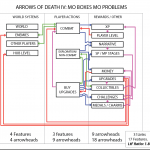A Beginner’s Guide to Level Design (tutsplus.com)
Today, Tutsplus published an article I've been working on for a few months: A Beginner's Guide to Level Design The article describes my process for designing levels, and as it…
Economy Balancing Models
When you have a game system that involves the player using loot to buy rewards, I usually start calling that system an "economy." (Note: This isn't how some people use the word,…
October 2015 Patreon Q&A #2
Mikes second monthly Patreon Q&A for October. 0:20 - How to communicate with players 0:50 - User testing 1:50 - Other types of feedback 3:10 - Users want everything to…
October 2015 Patreon Q&A #1
In this chat, Mike talks about Development Hell and what playing games is like as a game developer. Patreon Credits As always, these articles wouldn’t be possible without my supporters…
September 2015 Patreon Q&A
Topics this time include "How Mike got into making games," "balancing economies like in Ratchet and Clank" Patreon Credits As always, these articles wouldn’t be possible without my supporters on…
Chen Diagrams
This picture does not match the content around it. It is merely here to give the impression that this article is not all about words. Stupid words! In my fourth…
The Other Side
It was April, and things were still cold when I found myself in front of the offices of Insomniac Games' old offices, near Universal City Walk. I was on the…
Learning from other Media
About five years ago or so, I felt like I needed to improve my game design skills, so I looked around to see what kind of books there were out…
Telegraphs 2: Post-attack vulnerability
Previous Article | Next Article My post on telegraphing enemy attacks, was about making an enemy telegraph before it attacks to ask the question: "Can you avoid my attack?" This…
Reward Schedules
Carnival games are a great example of reward schedules. Since we've now established the best way to influence player behavior is via rewards, I want to talk about the ways…





